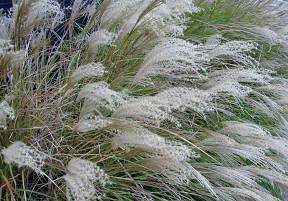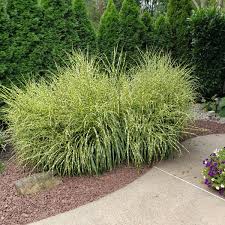Zebra Grass, scientifically known as Miscanthus sinensis ‘Zebrinus’, is a really cool plant that looks like a zebra with its stripes. It’s a kind of grass that people like to grow in their gardens because it’s so interesting to look at. This plant comes from East Asia, which is a faraway place, and it has become pretty popular in gardens all around the world.
Imagine a grass that’s like a piece of art in your garden. That’s what Zebra Grass is like. It grows to be about as tall as a grown-up person, around 4 to 6 feet. That’s like having a tall friend hanging out in your yard! And the best part is, you don’t need to do a lot of work to take care of it.
Zebra Grass is not picky about where it lives. It can grow in soil that drains well, which means water doesn’t stay on top of it for too long. It also likes the sun, but it’s okay with a little bit of shade too. That’s good news because it means you can put it in different parts of your garden and it will still be happy.
When it’s late summer or early fall, Zebra Grass gets even more interesting. It grows these fluffy things that look like feathers on top of the grass. These feathers start off red and then turn white, like magic! They move around in the wind and make the garden look like a fairy tale. It’s like having a party in your yard!
People use Zebra Grass in lots of ways in their gardens. Some like to put it all by itself so everyone can see it. Others use it as a fence to keep their garden private. You can even use it to make the edges of your garden look really nice.
Taking care of Zebra Grass is pretty easy. When it’s wintertime, you can give it a little haircut by trimming the old parts. This helps it stay healthy and ready for the next year. Just imagine giving your plant a nice, neat haircut so it can look its best!
However, Zebra Grass is a special kind of plant that adds a bit of nature’s art to your garden. Its zebra stripes, easy-going personality, and fluffy feathers make it a hit with garden lovers. Whether it’s standing on its own, giving you privacy, or just being part of your garden adventures, Zebra Grass is like a friendly and stylish guest that always brightens up the place.
Read Also: Methods to use in Cross-Breeding Animals
Growing and Care Guide of Zebra Grass

Zebra Grass, also known as Miscanthus sinensis ‘Zebrinus’, is a fantastic plant to have in your garden. It’s easy to grow and looks amazing with its zebra-like stripes. If you’re new to gardening or just want a low-maintenance plant that adds a touch of elegance, Zebra Grass is a great choice. Here’s a simple guide to help you grow and care for this beautiful ornamental grass:
Planting Zebra Grass
1. Choose the Right Spot: Find a sunny spot in your garden where Zebra Grass can get at least 6 hours of sunlight each day. It can tolerate some shade, but more sun is better for its growth.
2. Prepare the Soil: Make sure the soil drains well and doesn’t get waterlogged. You can mix in some compost to improve the soil’s texture and fertility.
3. Planting Time: The best time to plant Zebra Grass is in the spring or early fall. Dig a hole that’s about twice the size of the plant’s root ball. Place the plant in the hole and backfill with soil.
Caring for Zebra Grass
1. Watering: Water the plant regularly during its first growing season to help it establish strong roots. Once it’s established, Zebra Grass is pretty drought-tolerant and doesn’t need a lot of water.
2. Mulching: Apply a layer of mulch around the base of the plant to help retain moisture and keep weeds at bay. This also helps to protect the plant during colder months.
3. Pruning: In late winter or early spring, trim back the old foliage to about 6 inches above the ground. This helps rejuvenate the plant and encourages new growth.
4. Dividing: Every few years, you might notice that your Zebra Grass has grown quite big. It’s a good idea to divide the plant to keep it healthy. Dig up the plant, separate the clumps, and replant them in different areas of your garden or share them with friends.
5. Fertilizing: Zebra Grass doesn’t need a lot of fertilizer. You can apply a balanced, slow-release fertilizer in the spring if you want to give it a little boost.
6. Pest and Disease Control: Zebra Grass is generally not bothered by pests or diseases. Keep an eye out for any unusual signs like discoloration or wilting, and take action if needed.
7. Winter Care: Zebra Grass is quite hardy, but if you live in a colder climate, you can provide some extra protection by adding a layer of mulch around the base of the plant before winter.
Remember, gardening is a journey of learning and experimenting. With its eye-catching beauty and easy care, Zebra Grass can be a wonderful addition to your outdoor space. Enjoy watching it grow and add a touch of elegance to your garden landscape.
Read Also: Factors to be considered before Cross-Breeding
Uses of Zebra Grass

Here are some different uses of Zebra Grass (Miscanthus sinensis ‘Zebrinus’):
1. Ornamental Focal Point: Zebra Grass is often used as a striking focal point in gardens and landscapes due to its unique zebra-like stripes and tall, elegant growth habit. Planted as a standalone specimen, it draws attention and adds a touch of drama to any outdoor space.
2. Privacy Screening: With its dense and tall growth, Zebra Grass is an excellent natural screen that provides privacy and blocks unwanted views. Planting a row of Zebra Grass can create a stylish and effective privacy barrier.
3. Border Planting: Zebra Grass can be planted along garden borders to create a defined edge between different planting areas. Its attractive foliage adds a border that stands out, especially when combined with other plants.
4. Textural Contrast: When used in combination with other plants, Zebra Grass provides a textural contrast that enhances the overall visual appeal of the garden. Its upright, linear leaves contrast well with the rounded forms of flowers and shrubs.
5. Wildlife Habitat: Zebra Grass can attract birds and pollinators, offering them a place to rest, feed, and seek shelter. The plume-like inflorescences provide a food source for birds, while the foliage offers cover for small animals.
6. Naturalistic Landscaping: In naturalistic or prairie-style landscapes, Zebra Grass blends seamlessly with native plants, contributing to a harmonious and ecologically balanced environment.
7. Erosion Control: The extensive root system of Zebra Grass helps stabilize soil and prevent erosion, making it a useful plant for slopes and areas prone to soil movement.
8. Cut and Dried Arrangements: The fluffy plumes of Zebra Grass can be cut and dried for use in floral arrangements. Their unique texture and appearance add interest to indoor décor.
9. Educational Gardens: Zebra Grass can be utilized in educational gardens to showcase different plant types, growth patterns, and the concept of ornamental grasses.
10. Commercial Landscaping: Landscapers and designers often incorporate Zebra Grass in commercial landscapes, parks, and public spaces to add visual interest and a touch of natural beauty.
11. Low-Maintenance Landscaping: Zebra Grass is a low-maintenance plant that requires minimal care once established, making it an ideal choice for busy homeowners and those looking for easy-to-care-for landscaping options.
12. Elegant Walkways: Placing Zebra Grass along walkways or paths can create an inviting and visually appealing journey through your garden.
These various uses demonstrate the versatility of Zebra Grass in enhancing the aesthetics and functionality of gardens, landscapes, and outdoor spaces. Whether you’re looking to create a focal point, provide privacy, attract wildlife, or simply add beauty to your surroundings, Zebra Grass has a role to play.
Read Also: How To Make A Gum Wrapper Chain
